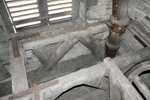For this church:    |
Cromwell St GilesBells
The western tower contains a ring of three bells. The timber frame (Elphick V or Pickford truss type 6.B), now in very poor order, is the original late medieval one with unusual curved braces, on which carpenters’ marks II II and III III for assembly were recognised by Dr Christopher Brooke in 1981. Though there are now only three bells, part of the framing was assembled in a space for a fourth, smaller one, which would have been swung at right angles to the other three. In 1552 it was noted that there were ‘ij belles of brass one sanctus bell hanging in the steple’, and in the winter of 1612-13, a great storm caused two to fall. Almost certainly these were the Treble and Tenor noted below, after which the Second may have been added at the rehanging. The terrier of 1764 mentions that three bells were then in use. In 1875, two years after the restoration of the church, a fund was set up for restoring these. They were repaired in 1877; partly thanks to money sent from Calcutta by the son of the then rector, Henry Fiennes-Clinton, when two of the bells were re-hung by Messrs Taylor of Loughborough at a total cost of £36. The bells are hung for full circle ringing in a low sided wooden frame for three bells, with wooden headstocks and plain bearings; the present fittings date from the mid 19th century. Inspection by Taylors of Loughborough in 2011 revealed that ‘the bells have never had a great deal of use’, show little sign of wear and no cracking. However, because of the state of the frame and fittings, they were no longer safe to ring in 2011. Notes
| |||||||||||||||









